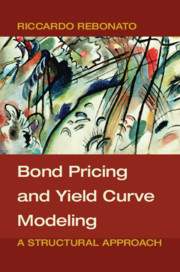Book contents
- Frontmatter
- Dedication
- Contents
- Acknowledgements
- Symbols and Abbreviations
- Part I The Foundations
- Part II The Building Blocks: A First Look
- Part III The Conditions of No-Arbitrage
- Part IV Solving the Models
- Part V The Value of Convexity
- Part VI Excess Returns
- 23 Excess Returns: Setting the Scene
- 24 Risk Premia, the Market Price of Risk and Expected Excess Returns
- 25 Excess Returns: Empirical Results
- 26 Excess Returns: The Recent Literature – I
- 27 Excess Returns: The Recent Literature – II
- 28 Why Is the Slope a Good Predictor?
- 29 The Spanning Problem Revisited
- Part VII What the Models Tell Us
- References
- Index
28 - Why Is the Slope a Good Predictor?
from Part VI - Excess Returns
Published online by Cambridge University Press: 25 May 2018
- Frontmatter
- Dedication
- Contents
- Acknowledgements
- Symbols and Abbreviations
- Part I The Foundations
- Part II The Building Blocks: A First Look
- Part III The Conditions of No-Arbitrage
- Part IV Solving the Models
- Part V The Value of Convexity
- Part VI Excess Returns
- 23 Excess Returns: Setting the Scene
- 24 Risk Premia, the Market Price of Risk and Expected Excess Returns
- 25 Excess Returns: Empirical Results
- 26 Excess Returns: The Recent Literature – I
- 27 Excess Returns: The Recent Literature – II
- 28 Why Is the Slope a Good Predictor?
- 29 The Spanning Problem Revisited
- Part VII What the Models Tell Us
- References
- Index
Summary
“Anything that happens, happens.
Anything that, in happening, causes something else to happen, causes something else to happen.
Anything that, in happening, causes itself to happen again, happens again.
It doesn't necessarily do it in chronological order, though.”
–Douglas Adams, Mostly HarmlessTHE PURPOSE OF THIS CHAPTER
We have seen in the previous chapters that the slope is one of themost important return-predicting factors. Theremay be (slightly)more powerful predictors, but we have made the case that the slope tells a substantial part of the story. We stress that we do not claim that the slope is the only predictor. In this chapter we simply argue that it explains an important part of the observed return predictability. Even as they propose the tent-shapes return-predicting factor, Cochrane and Piazzesi (2004) agree on this point. Cieslak and Povala (2010a, 2010b) implicitly qualify the importance of the slope predictor by making it conditional (on where it ‘should be’ given the long-term inflation) – see the interpretation we give in Equation (27.56). And we have also shown that batlike or tent-like return-predicting factors or ‘conditional slopes’ can be interpreted as ‘refinements’ of the slope predictor. In sum: from the empirical perspective, we can confidently say that the (unconditional) slope still remains an important factor to predict excess returns. What we have not answered is the all-important question of why this should be the case.
In this chapter we present four possible explanations for this empirically observed regularity. In a nutshell,
• the first suggests that ‘we now know’ what earlier investors could not have known (for instance, because their record of data was shorter, or their statistical methods less powerful);
• the second points to the possibility that the risk aversion of investor may depend on business-cycle–related economic conditions;
• the third accounts for the slope dependence by invoking heterogeneous beliefs associated with different cohorts of (smart and noise) traders and wealth fluctuations between the two classes; and
• the fourth possible explanation is that investors guess (on average) correctly the direction of ratemoves, but over-react. By doing so, upwardsloping curve become ‘too’ steep, and so do downward-sloping yield curves.
Information
- Type
- Chapter
- Information
- Bond Pricing and Yield Curve ModelingA Structural Approach, pp. 527 - 546Publisher: Cambridge University PressPrint publication year: 2018
